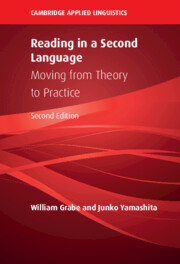Book contents
- Reading in a Second Language
- The Cambridge Applied Linguistics Series
- Reading in a Second Language
- Copyright page
- Dedication
- Contents
- Figures
- Tables
- Preface
- Part I Foundations of Reading
- 1 The Nature of Reading: Defining Reading
- 2 How Reading Works: The Building Blocks of Fluency and Comprehension
- 3 How Reading Works: Comprehension Processes
- 4 Cognitive Issues in Reading
- 5 Neurocognitive Processing and Reading Ability
- 6 Explaining Reading Comprehension: Models of Reading
- Part II Patterns of Variation in Reading
- Part III Developing Reading Comprehension Abilities
- Part IV Expanding Reading Comprehension Skills
- Part V Applications of Reading Research: Instruction and Assessment
- References
- Author Index
- Subject Index
6 - Explaining Reading Comprehension: Models of Reading
from Part I - Foundations of Reading
Published online by Cambridge University Press: 01 September 2022
- Reading in a Second Language
- The Cambridge Applied Linguistics Series
- Reading in a Second Language
- Copyright page
- Dedication
- Contents
- Figures
- Tables
- Preface
- Part I Foundations of Reading
- 1 The Nature of Reading: Defining Reading
- 2 How Reading Works: The Building Blocks of Fluency and Comprehension
- 3 How Reading Works: Comprehension Processes
- 4 Cognitive Issues in Reading
- 5 Neurocognitive Processing and Reading Ability
- 6 Explaining Reading Comprehension: Models of Reading
- Part II Patterns of Variation in Reading
- Part III Developing Reading Comprehension Abilities
- Part IV Expanding Reading Comprehension Skills
- Part V Applications of Reading Research: Instruction and Assessment
- References
- Author Index
- Subject Index
Summary
Chapter 6: Explaining Reading Comprehension: Models of Reading. This chapter reviews the major current model of reading comprehension that underlie much of current research on reading comprehension, both in L1 and L2 contexts. The chapter quickly notes more metaphorical explanations and then moves on to models and frameworks that are key for interpreting reading comprehension research: the Simple View of Reading, the Construction-Integration Model, the Landscape Model, the Verbal Efficiency Model, and the Reading Systems Framework Approach. The chapter closes with a specific discussion of L2 reading comprehension as interpreted by current models, and finally with implications for instruction.
Keywords
Information
- Type
- Chapter
- Information
- Reading in a Second LanguageMoving from Theory to Practice, pp. 129 - 144Publisher: Cambridge University PressPrint publication year: 2022
